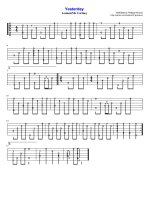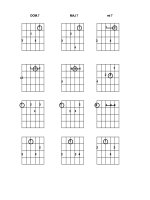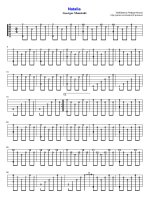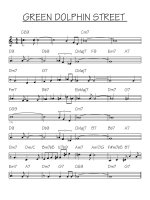RITI HRM diploma handouts full version tủ tài liệu bách khoa
Bạn đang xem bản rút gọn của tài liệu. Xem và tải ngay bản đầy đủ của tài liệu tại đây (17.36 MB, 246 trang )
Human Resources Management
Professional Diploma
March 2011
Master Trainer: Mr. Sherif Lotfy
Material Copy right is reserved
Trainer Qualifications
Mr. Sherif Lotfy
Mr. Lotfy is a Management Consultant specialized in the field of Human Capital and Training Consulting. he obtained his Business
Administration degree from Helwan University majored in Foreign Trade section, followed by an MBA from Academy of Science
and Technology in collaboration with French University (ESLSCA), which he achieved first rank in research involved in "The impact
of knowledge management and intellectual capital on raising the organization's performance". He is now pursuing his doctoral
degree with Maastricht School of Management (MsM), the Netherlands. His thesis work in progress involved the evaluation
Strategic Human Resources functions and its impact on the overall corporate performance.
Currently, Mr. Lotfy is the Managing Director of Brilliance for Human Capital Consulting. He is also working as an Independent
Business Management Consultant/ Instructor/ Coach under this Entity. In parallel Mr. Lotfy is a part time lecturer in many other
reputable institutes.
Being mainly specialized in Human Capital field, during the past five years, Mr. Lotfy achieved several management consultancy
assignments mainly in the areas of human resources, training and sales fields; particularly in training needs analysis and training
consultancy, evaluation of training programs, job analysis and job profiling, recruiting and selection, assessing the employees’
capabilities, skills and competencies, assessment centers, building HR competency framework, creating and auditing on
performance appraisal, formulating KPI’s and building performance management system.
Moreover Mr. Lotfy delivered several training and workshops ‐ tailor made and ready made, international and local courses in
various fields mainly in human resources and training fields as well as training of the trainer (TOT) diplomas, training needs
analysis, human resources courses in various fields for HR professionals includes, job analysis and profiling, behavioral and
competency‐based Interviewing skills, performance appraisal skills, performance management system, HR for non HR. other
trainings and workshops in fields of Management and Leadership, Sales, Contact and Call Centre, Emotional Intelligence and
Interpersonal Skills, Creative Thinking skills, Problem Solving and Decision Making, attitude and perception and team building.
The Consultancy projects and training workshops carried out with a multitude of industries, businesses and services including:
telecommunications, FMCG’s, manufacturing, cement, chemicals, printing, real estate, information technology, retailing, hotel
and tourism, banking, garment, home appliances, vehicles spare parts, automotive, food processing, communication and
computer, petroleum engineering, heavy machinery and tracks, aviation and low voltage electrical distribution industries.
Before that, and for Almost 8 years, Mr. Lotfy had a very rich professional experience in leading multinational companies such
as: PGESCo entity of Bechtel Egypt Corporation, Vodafone Egypt, Moevenpick Hotels and Resorts and other consulting and
training providers.
Mr. Lotfy started as an accountant in PGESCo entity of Bechtel Egypt Corporation where he got the practical experience in
multinational companies in the field of accounting. After that, Mr. Lotfy had joined Vodafone Egypt where he worked in customer
operations department and sales department where he was mainly responsible for quality assurance of the customer operations
and sales staff. Mr. Lotfy conducted several training courses within the departments. After 4 years, Mr. Lotfy joined Moevenpick
Hotels and Resorts chain in the post of training and quality assurance head where he was responsible with his team for all the
related issues of training and quality.
After Mr. Lotfy’s achievements in the training department, he performed HR consultancy for the Human Recourse Department
and other department heads. He was also one of the executive committee members in the hotel, which involved the making of
strategic decisions for the hotel.
For the next 4 years, Mr. Lotfy worked as a management consultant and trainer in the field of HR and developing people’s skills
and competencies. He worked as a consultant with Ministry of Communication and IT (MCIT) in the project of evaluating and
assessing the service providers who are bidding to provide their service of training and developing the graduates on soft skills,
computer skills and English language skills. Also, he worked as an independent consultant and freelance trainer with many
multinational and domestic companies. Also, he worked with several reputable service providers include; Dale Carnegie, RITI,
Amcham, Logic Management Consulting and Innovative Group.
Mr. Lofty has acquired a vast experience especially in the multinational sector. His experience can be adapted and implemented
to different organizations. He has a passion for dealing with people, thus he established himself in various industries from the
start by being a customer oriented guided by the highest quality standards. Mr. Lotfy is an active member in some society and
charity associations.
© Human Resources Management Professional Diploma, 2010 – Developed by Mr. Sherif Lotfy
2
Diploma Outline
Module 1 Strategic Management
Strategic Management and Planning - Definition
Corporate Governance Concept
Steps of Strategic Management process
Environmental Scanning
o Environmental Scanning - External factors
o Porter Forces – Industry Analysis
o Environmental Scanning - Internal factors
Strategy formulation
o Vision and mission – Importance and Concept
o External and internal factors - SWOT Analysis
o Tows Matrix
Types of strategies in organization
Types of Corporate Directional Strategy
o External mechanisms: merge, acquisition and alliance
Business portfolio and Portfolio Analysis
o The Boston Consulting Group (BCG) Matrix
o The General Electric (GE) Business Screen
Different Strategies for business units
o Cooperative Strategy
o Competitive Strategy
o Cost leadership, differentiation and focus strategy
Different functional Strategy
Strategy implementation
Evaluation and Control
Strategic Role of HR in the organization
© Human Resources Management Professional Diploma, 2010 – Developed by Mr. Sherif Lotfy
3
Module 2 Concepts of Human Recourses Management
•
•
•
•
•
•
Human Resource Management
Different Roles for HRM
HR from Supporting Function to Strategic Partner
Changing Roles of HR Management
HR Strategy Alternatives
HR Responsibilities and functions
Module 3 Job analysis and Competency Framework
• Job Analysis – Definition and Concept
• The nature of job analysis
• Different methods of collecting job analysis
o Interviews
o Questionnaire
o Observation
o Diary / Logs
• Job descriptions – Formulation
• Job specification from the job description
• Competency framework– Definition and Concept
• Competency role in Corporate culture
• Competency-based Human Recourse
• Components of Competency Framework
• Types of competencies
• Competencies needed for different jobs
• Behavioral indicators
© Human Resources Management Professional Diploma, 2010 – Developed by Mr. Sherif Lotfy
4
Module 4 Personnel Planning and Recruitment
•
•
•
•
•
•
•
•
•
•
Techniques in employment planning and forecasting
Market Analysis and Recruitment Channels
Different types of tests and assessments
Techniques of selection interviews
Integrate competencies in the selection process
Skills required for interviewer in selection process
Behavioral-based interview techniques
Reveal the required information from the candidate
Evaluate answers given by the candidate
Measurements with evaluation scale
Module 5 Training and Development
•
•
•
•
•
•
•
•
•
Define Learning, Education, Training & Development
Understand Nature of Adult Learning
Types of Adult Learning
Recognize Training Generic Model
Identify steps of Training Needs Analysis
Analysis the performance gap
Identify training versus Non-training solutions
How to select a Service Provider
Methods of Training Evaluation – Kirkpatrick Model
o Participant's reaction
o Learning
o Transfer / Behavior
o Return on Investment (ROI)
© Human Resources Management Professional Diploma, 2010 – Developed by Mr. Sherif Lotfy
5
Module 6 Performance Management System (PMS)
•
•
•
•
PMS from traditional views to new concepts
Performance management versus performance appraisal
Performance Management System Misconceptions
Explain the Performance Management System Model
o
o
o
o
Performance Planning
• Key responsibilities and job descriptions
• Cascading Objectives and Action plan
• Behavioral indicators
Performance Monitoring & Coaching
• Observe, monitor and coach
• Deliver feedback
• One on one sessions
Performance Appraisals
• Compile/Review data
• Parties’ appraisals
• Appraisers rating errors
Learning and Development
Module 7 Compensation and Benefits Management
•
•
•
•
•
•
•
•
•
Methods in compensation planning
Factors in determining pay rates
Explain how to price managerial and professional jobs
Discuss current trends in compensation
Incentives for individual employees
Develop effective incentive plans
Insurance and other job benefits
Discuss the main retirement benefits
Flexible benefit employee programs
© Human Resources Management Professional Diploma, 2010 – Developed by Mr. Sherif Lotfy
6
Module 8 Labor Law and Social Insurance
•
•
•
•
•
•
•
•
•
•
Employment, hiring and hiring Foreign labor
Work Contract, working hours and Leaves
Female Labor and Children Labor
Termination of Work Relation and Workers Duties
Health and Safety
Procedures for social security memberships
The membership ratios
Purchasing of insurance durations
General conditions for receiving the pension
Cover Work Injury and illness Social Care
Final Project Law and Social Insurance
© Human Resources Management Professional Diploma, 2010 – Developed by Mr. Sherif Lotfy
7
Final Project Graduation
Goals I want to achieve from the diploma ….
© Human Resources Management Professional Diploma, 2010 – Developed by Mr. Sherif Lotfy
8
MODULE
1
Strategic Management
Learning Objectives
Define Strategic Planning
Define Strategic Management
Identify steps of Strategic Management process
Explain the vision and mission
Assess internal and external factors
Conduct SWOT Analysis
Identify how to formulate strategies
Hierarchy of strategies along the organization
Types of Corporate Directional Strategy
External mechanisms: merge, acquisition and alliance
Business portfolio and Portfolio Analysis
o The BCG (Boston Consulting Group) Matrix
o The GE (General Electric) Business Screen
Different functional Strategy
Know steps of strategy implementation
© Human Resources Management Professional Diploma, 2010 – Developed by Mr. Sherif Lotfy
9
Strategic Management
Strategic Management
It is a set of managerial decisions and actions that determines the longrun performance of a corporation.
Strategy
9 A strategy is a course of action.
9 The company’s long-term plan for how it will balance its internal
strengths and weaknesses with its external opportunities and threats to
maintain a competitive advantage.
© Human Resources Management Professional Diploma, 2010 – Developed by Mr. Sherif Lotfy
10
Strattegic Maanagem
ment Mod
del
Steep 1: Perfform Exteernal and Internal
I
A
Audits
Steep 2: Defiine the Buusiness an
nd Its Mission
Steep 3: Tran
nslate the Mission into
i
Strateegic Goals
Steep 4: Form
mulate a Strategy
S
to
o Achievee Strategicc Goals
Steep 5: Implement th
he Strategyy
Steep 6: Evalluate Perfformance
Step 1: Environmen
ntal Scan
nning
t monito
oring, evaaluating, aand dissem
minating of
o informaation from
m
It is the
the exxternal an
nd internall environm
ments to key
k peoplle within the
t
corpo
oration.
Strateegic factorrs
They are thosee external and intern
nal elemeents that w
will determ
mine the
orporations.
futuree of the co
Interrnal and
d Extern
nal Facto
ors
Inteernal Enviironment::
E
External
E
Environme
ent:
Variables within
w
thee
¾V
organizati
o
ion itself
¾ Variablees outsidee the
¾V
Variables form
f
the
context
c
in
n which th
he
work
w
is do
one.
¾U
Usually wiithin the top
t
managem
m
ment’s control.
organizaation
¾ Variablee forms th
he
contextt the corpo
oration
exists
¾ Not witthin the to
op
manageement’s co
ontrol
External Factors
I - PEST variables:
Political/ Legal Factors:
Monopolies legislation
Environmental protection laws
Taxation policy
Employment laws
Government policy
Legislation others?
Economic Factors:
Inflation
Employment
Disposable income
Business cycles
Energy availability and cost others?
Socio-cultural Factors:
Demographics
Distribution of income
Social mobility
Lifestyle changes
Levels of education others?
Technological Factors:
New discoveries and innovations
Speed of technology transfer
Rates of obsolescence
Internet
Information technology others?
© Human Resources Management Professional Diploma, 2010 – Developed by Mr. Sherif Lotfy
13
II - Industry Analysis – Michael Porter's Forces
•
•
•
•
•
•
Threat of new entrants
Rivalry among existing firms
Bargaining Power of buyers
Bargaining power of Suppliers
Threat of substitute products and service
Relative Power of Other Stakeholders
© Human Resources Management Professional Diploma, 2010 – Developed by Mr. Sherif Lotfy
14
Industry Analysis: Threat of New Entrants
Economies of scale
Product differentiation
Capital requirements
Switching costs
Access to distribution channels
Cost disadvantages
Government policy
Industry Analysis: Rivalry among Existing Firms
Number of competitors
Rate of industry growth
Product or service characteristics
Amount of fixed costs
Capacity
Height of exit barriers
Diversity of rivals
Industry Analysis: Other Forces
Threat of Substitute Products or Services
Bargaining Power of Buyers
Bargaining Power of Suppliers
Relative Power of Other Stakeholders
© Human Resources Management Professional Diploma, 2010 – Developed by Mr. Sherif Lotfy
15
Internal Environment
Internal strategic factors
Critical strengths and weaknesses those are likely to determine if the firm
will be able to take advantage of opportunities while avoiding threats
¾ Structure:
Chain of Command
¾ Culture:
Beliefs, Expectations, Values
¾ Resources:
Assets, skills, competencies, knowledge
Resources
Capabilities
Competency
Core competency
Distinctive competency
© Human Resources Management Professional Diploma, 2010 – Developed by Mr. Sherif Lotfy
16
Internal Factors: Structure
Basic Organizational Structures
– Simple structure
– Functional structure
– Divisional structure
– Strategic business units (SBU’s)
– Conglomerate structure
© Human Resources Management Professional Diploma, 2010 – Developed by Mr. Sherif Lotfy
17
Interrnal Envvironmeent: Cullture
b
exp
pectations, and values learneed and shared by a
Collection of beliefs,
oration’s members
m
om one generation
n of
and transsmitted fro
corpo
emplo
oyees to another
a
Inteernal En
nvironm
ment: Resources
• Resourcees
• Capabilities
• Compettency
• Core competency
y
• Distincttive comppetency
Exteernal an
nd Internal Envvironment
External and Internal Environment
External Environment:
PEST variables:
9
9
9
9
Political
Economical
Social
Technological
Industry Analysis
Opportunities and Threats
Internal Environment:
Structure:
Chain of Command
Culture:
Beliefs, Expectations, Values
Resources:
Assets, skills, competencies, knowledge
Strength and Weakness
© Human Resources Management Professional Diploma, 2010 – Developed by Mr. Sherif Lotfy
19
SWO
OT Anaalysis
Simp
ple ruless for succcessful S
SWOT analysis
a
• Guuide, not a prescripption
• Distinguish
D
h betweenn today annd the futture
• Avoid
A
greyy areas bee specific
• Avoid
A
com
mplexity
OT summaarizes ressults of m
market anaalysis, sugggests strategic
SWO
directtion
Make Your SWOT
© Human Resources Management Professional Diploma, 2010 – Developed by Mr. Sherif Lotfy
21
Strattegy Foormulatiion
Strattegy Form
mulation
n
¾ Is the development of
o long-ran
nge plans for the effective manageme
m
ent
¾ It includes
i
Defin
ning the co
orporate m
mission,
Speciffying achievable ob
bjectives,
Develloping straategies, an
nd
Settingg policy guidelines
g
.
Defiinition and
a Concept
A
Situaational Analysis
between external
e
op
pportunitiies and
Proceess of findding a straategic fit b
intern
nal strengtths while working around
a
exxternal thrreats and internal
weakn
nesses
TWO
OS Mattrix
Business Vision
V
a Misssion
and
Busin
ness Visio
on and Mission
M
Vision
n:
v
con
ncerns a firm’s
f
futu
ure busin
ness path
A sttrategic vision
o The kind
k of com
mpany it is trying to
t becomee
o Custo
omer needds to be saatisfied in the future
Missiion
nt businesss activitiees
A mission statementt focuses on curren
ompany is in now
o Business(as) co
Business Vision and Mission
:
Vision A general statement of its intended direction that evokes
emotional feelings in organization members.
:
Mission Spells out who the company is, what it does, and where
it’s headed.
Why Do You Need a Vision?
9 Vision is a picture of a future state that guides current behavior.
9 Future vision must be significantly different than the current state.
9 The gap between the current state and future state produces creative
energy.
© Human Resources Management Professional Diploma, 2010 – Developed by Mr. Sherif Lotfy
25









